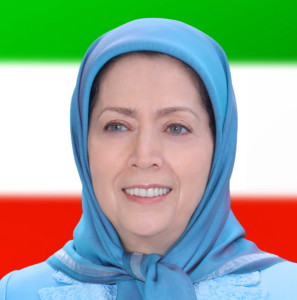Maryam Rajavi: Why is June 20, 1981, a historic landmark for Iran
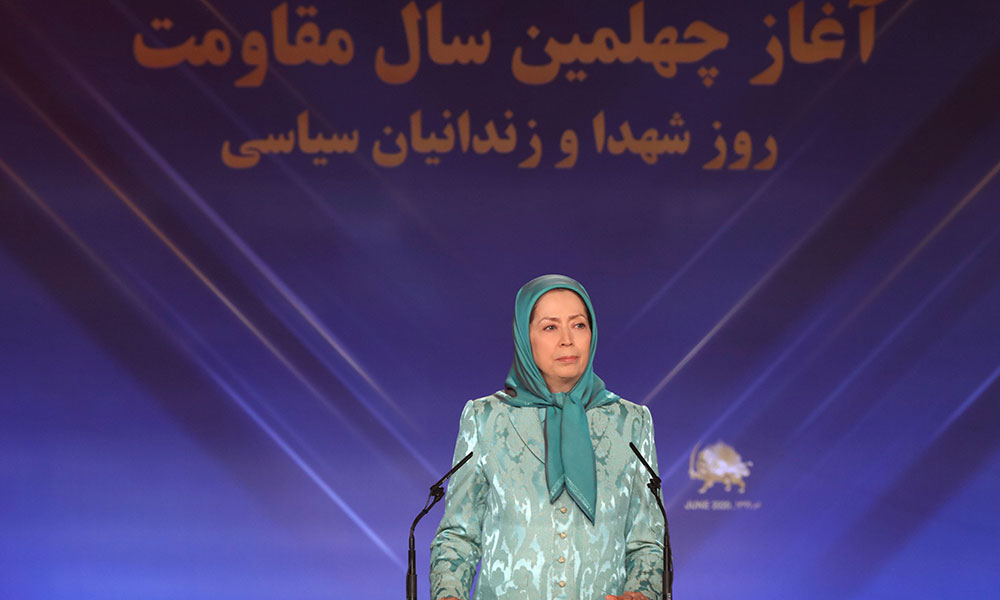
June 20, 1981, drew a line between two destinies and two historic prospects
Saturday, June 20, 2020 – On 40th anniversary of the beginning of the Iranian people’s resistance against the mullahs’ religious dictatorship, an international online conference was held in the presence of Maryam Rajavi. Some 2,000 locations around the world and Ashraf 3 in Albania were connected to the virtual conference.
Speakers and participants celebrated the 40th year of the Iranian people’s resistance, the Day of Martyrs and Political Prisoners, and the anniversary of the foundation of the National Liberation Army of Iran. June 20, 1981, was a turning point in the Iranian people’s steadfast resistance to overthrow the mullahs’ dictatorship and declared support for the struggle of the Iranian people and resistance.
Iranian communities in different countries and their representatives as well as political personalities, members of parliament, human rights defenders and supporters of the Iranian resistance from around the world participated in this conference. A number of them addressed the conference and others sent messages of solidarity with the Iranian people’s resistance and uprising.
A representative of PMOI women, former political prisoners in the 1980s, also addressed the conference.
In parts of her speech to this conference, Maryam Rajavi said:
Fellow compatriots,
Brave rebellious protesters and Resistance Units in Iran,
Families of martyrs and political prisoners,
We are commemorating June 20th, which this year marks the 40th anniversary of the start of the nationwide resistance against the mullahs’ religious dictatorship. It is also the Day of Martyrs and Political Prisoners in Iran, and the anniversary of the founding of the National Liberation Army of Iran.
We extend our commendations to those who created this landmark turning point in Iran’s contemporary history! Many salutations to Massoud Rajavi, the leader of this historic uprising!
Hail to the generation of June 20, 1981, and their galaxy of martyrs, from Ashraf Rajavi and Moussa Khiabani, to Sedigheh Mojaveri and Neda Hassani, to the latest martyr of Resistance Units.
In Iran’s contemporary history, there has never been any development like June 20, 1981, which clearly drew a profound line between the camps of freedom and tyranny in Iranian society.
And there has never been a turning point that advanced, to such an extent, Iranian society towards freedom and justice.
A similar confrontation or duality existed during the Constitutional Movement and in the course of the oil nationalization movement led by the late Dr. Mohammad Mossadeq. But in the past century, it had never evolved or matured into such an unambiguous separation between the two camps.
So, June 20, 1981, separated good and evil. It demarcated between two paths, two destinies and two historic prospects.
June 20, 1981, drew the line between tyranny and freedom, between the mullahs’ superstitious and reactionary interpretation of Islam, and the genuine Islam which heralds freedom and emancipation.
It drew the line between opportunism and hollow pretenses on the one hand, and sacrificing and paying the price of freedom on the other.
June 20th drew the line between submission to the mullahs’ religious fascism and aligning with the shah and the clerics, on the one hand, and remaining steadfast, proud and choosing to make the ultimate sacrifice, on the other.
June 20, 1981, drew the line between what one must not do, and what one must do; the line between submission and compromise on the one hand and waging resistance at any cost, on the other; between regret and repentance on the one hand, and taking a stance for resistance, struggle and upholding commitments, pledges and unwavering principles on the other.
Historically, June 20, 1981 is the flip side of August 19, 1953, when political parties of the time succumbed to passivity and despair in the face of the coup d’état (against Dr. Mossadeq).
On June 20, 1981, however, one can clearly see that in virtue of perseverance and resistance, victory will be achieved.
Two days ago, on the 80th anniversary of General De Gaulle’s call to the people of France to rebel against appeasement and surrender and to continue the resistance, French President Emanuel Macron recalled Gen. De Gaulle’s message to resolute women and men to never accept defeat and never surrender.
Compatriots, dear friends,
Iran’s 40-year history clearly shows the necessity and rightfulness of June 20, 1981. For this reason, the passage of all these years has failed to push it into oblivion.
The day after June 20, 1981, Khomeini’s Revolutionary Prosecutor published the photos of teenage girls supporting the PMOI/MEK who had been executed. He urged their families to go and identify the bodies of their children because they had not given their names, instead only identifying as “Mojaheds” (PMOI/MEK) and when asked. And they chanted, “long live freedom,” until the final moment before being shot by firing squads.
Publishing those photos in daily newspapers back then, revealed, before anything else, the cold heartedness and the ruthlessness of Khomeini and his Revolutionary Guards.
The passage of time, however, revealed a greater truth: Those young girls, those clenched fists, those cries of “long live freedom,” and their refusal to even tell their names to their executioners, created a new and admirable example in the context of revolutions; the new model of an unsung hero, innocent, but ready to make the ultimate sacrifice, something diametrically opposed to Khomeini. And, most importantly –as Khomeini said himself– they set an example for remaining firm on their beliefs, for being uncompromising and for persevering; in a historic sense, it can be summed up in one word: invincible.
They were the forerunners of a new generation who stepped onto the field of struggle and revolution. They broke through the barriers of the time, and rose up to resist against the most daunting reactionary force in Iran’s history.
Pretenders of all strips preceding them and the ideologies that lacked the capacity to continue the struggle fell by the wayside. A new generation stepped in, intent on paying the price for freedom from the onset.
My beloved Marjan who passed away earlier this month and whose art and commitment to struggle were praised by millions of our compatriots, said the following about her time in prison (in the early 1980s): “I met a young woman in prison, who was 24 or 25 years old. Her name was Shahin. She had been brought to the ward just after giving birth to her baby girl at Evin’s hospital. She named her daughter, Soulmaz, as her husband had asked before being executed. Soulmaz was his sister’s name who had been killed by the regime on September 27, 1981.”
Marjan added: “When the henchmen were taking Shahin for execution, she kissed little Soulmaz on the forehead. The baby was asleep and in the arms of her mother, she looked just like the drawing of Saint Mary by Michael Angelo. I could not take it anymore. I covered my face with my hands so that no one would hear me cry. I regained control over myself when Shahin caressed me on the head. For a moment, I gazed at her calm face and sombre smile. She placed little Soulmaz in my arms and walked away.”
Such scenes have been repeated thousands of times in the torture chambers of Khomeini and Khamenei.
The 1988 massacre of 30,000 political prisoners, 90% of whom were affiliated with the PMOI, marks one of the highest peaks of sacrifice for freedom. This was not a genocide where victims were targeted because of their ethnicity or race and regardless of their beliefs or choices. Rather, as it was urged in Khomeini’s fatwa (religious decree), the hangings took place after the executioners were confident that all the victims had made a conscious choice to adhere to their political beliefs and principles.
This is the most important aspect of the 1988 massacre, which distinguishes it from all other examples of mass murder.
In reality, Khomeini implemented a plan to fully uproot and exterminate the PMOI, but he failed to do so despite spilling an ocean of blood.
In the meantime, the 1988 massacre deepened the demarcation that was established on June 20, 1981. It amounted to drawing a blood-drenched boundary between those who struggle for freedom and those who are the enemies of freedom.
The rebellious generation which has risen up in the current uprisings of the people of Iran, has blossomed out of the rightfulness of those sacrifices.
The blood of those martyrs is still roaring. And on the anniversary of the 1988 massacre, the Iranian people and Resistance pledge to continue to call for justice until the leaders of the clerical dictatorship are brought to justice before the people of Iran.
Shortly before June 20, 1981, Khomeini addressed the PMOI/MEK and said: If there was the most miniscule probability in mind that you would give up what you want to do, I would have been willing to compromise with you…”
The practical meaning of these words –which PMOI members clearly understood at the time– was for the PMOI to write their final wills and prepare for detention and the most vicious tortures in the mullahs’ dungeons. They had to be prepared for being hanged from cliffs. And even if they persevered in Camp Ashraf, Iraq, they had to be prepared for bombings, rocket attacks, clubs and axes, as well as being run over by Humvees and loaders, and enduring the blasts of white torture by 320 loudspeakers.
The PMOI had to prepare for being assassinated in Pakistan, Turkey, Italy, and Switzerland. In Albania and France, too, the regime’s terrorist diplomats and mercenaries brought bombs and explosives to target them, in conjunction with a demonization campaign to insinuate that the clerical regime is better than the PMOI and the NCRI.
Now, look at the PMOI and their brilliant 40-year resistance and see how thousands upon thousands of them chose to kiss the noose during the 1988 massacre. See how they chose the name and path of Massoud Rajavi, i.e., the path of resistance and freedom, over the path to surrender.
Indeed, there was not the most miniscule probability that they would give up their struggle. And they will not do so, until the day Iran is free.
Yes, this is what it means to pay the necessary price, which is the distillation of this 40-year blood-soaked history.
And finally, they proudly achieved success in 20 international tribunals, and 33 campaigns in camps Ashraf and Liberty where many were martyred and wounded. Then they left behind millions of dollars’ worth of property for which they had worked for over 30 years, and were relocated to Albania, each with only 20 kg worth of belongings. There, in Ashraf 3, they launched another passionate struggle for freedom.
The aspiration for change
Dear compatriots,
Without such a selfless movement of the Iranian people, Iran’s political landscape would have been nothing but a desert of despair and passivity.
Researchers who have studied the psychological and social impacts of the Mongols’ invasion on Iran (in the 13th century) have reported on some painful examples of a lack of willpower in society to persevere during that period. It is written in history books: “If a Mongolian hat was suddenly thrown in among 1,000 people of Kharazm (Iran), all of them would run away in fear.”
But today, through its long-standing perseverance and model of steadfastness, the Iranian people’s organized resistance has impacted the collective conscience of Iranian society and shaped a different situation.
The series of anti-regime uprisings in recent years are the logical and historical continuation of the blood-drenched line drawn on June 20, 1981.
The uprisings which began in December 2017 and culminated in the fiery uprising in November 2019, has brought the strategy (of resistance) launched on June 20, 1981, into fruition in Iran’s streets. That strategy is now speaking loud and clear.
The November 2019 uprising that suddenly erupted in 900 locations throughout Iran in less than 48 hours, was of the same character and essence of the thunder that roared in Tehran’s cloudless sky on June 20, 1981.
During the November 2019 uprisings, the Islamic Revolutionary Guard Corps (IRGC) was ordered by Ali Khamenei (the mullahs’ Supreme Leader) to open fire on protesters and slaughtered at least 1,500 of them. The actual figures are estimated to be higher. But the clerical regime cannot contain a protest movement that has reached new heights and will be sustained by Resistance Units inside Iran.
Indeed, if it were not for the uprising of June 20, 1981, and the historical battle emanating from it, everyone would have succumbed to this regime, and nihilism and banality would have become prevalent.
The same holds true for the hollow pretenses of reform in 1997; and with the so-called “green” orientation during the 2009 protests. These are motivated by an ideology that denies the necessity of paying a price for freedom. In the end, through their chants of “principalists, reformer, the game is now over,” in December 2017, the rebellious youth put an end to the illusion of reform from within the ruling theocracy.
There was a similar situation under the Shah’s monarchic dictatorship before the resistance and sacrifices of the Mojahedin and Fedayeen. The maximum demands of all parties and politicians was reform within the dictatorship, urging the Shah to be the monarch and not the ruler. But in Iran’s circumstances, the Shah could not be the Shah if he did not become an absolute, totalitarian ruler.
Similarly, under the mullahs, if it were not for this resistance movement and the June 20, 1981 uprising, speaking of overthrowing the religious dictatorship would have been out of question. The maximum demand would have been for the mullahs to return to their preaching pulpits and give up political rule.
So, without June 20, 1981, and the roaring river of the blood of its martyrs, the demand to overthrow the regime in its entirety would not have become so prevalent, and there would not have been any subsequent uprisings.
Khomeini would not have been exposed to such an extent and regression and fundamentalism in Iran and the Middle East would have had no antithesis.
If it were not for the June 20, 1981 uprising, a democratic alternative could never have emerged against this regime. The National Council of Resistance of Iran (NCRI) would not have been founded and there would have been no trace of a forward-looking plan for Iran’s future.
A revolutionary generation, particularly with thousands of combatant and rebellious women, would not have emerged to turn the page in Iran’s history as it has done today. There would have been no breakthroughs for women’s equality and emancipation.
So, as Massoud Rajavi, the Iranian Resistance’s Leader, said, we have not been and are not at war with Khomeini as an individual. We are at war with “a historical swamp.” We are fighting against a regressive worldview and order represented by the mullahs. We are fighting against a prevalent approach that prefers the appeasement of, and complicity with, this regime.
But despite all the conspiracies, suppression, massacres, executions, bombings, warmongering, terrorism, demonization campaigns, and tons of lies and slanders, the PMOI’s organizational prowess and the NCRI, acting as the alternative to the regime, kept aloft the flag of resistance for the overthrow of the mullahs.
How momentous to have trained a generation of selfless and dignified women and men who are persevering in the frontline of this battle.
How momentous to have revitalized the values of resistance and humanitarian attributes, such as sacrifice, honesty, equality, tolerance, gender equality, freedom of choice, rejection of gender-based biases and narcissist egotism, as well as rejection of a fixation on positions of authority and power.
And how momentous that the Iranian Resistance has had so many achievements under the leadership of Massoud Rajavi. It will continue to create ground-breaking values until final victory.
My Compatriots,
Today, due to the inhuman policies of Khamenei and Rouhani, the coronavirus has spread like wildfire, claiming victims all over Iran.
Some of the regime’s officials confess that there are between 16 to 20 million people infected in Iran, while other officials say that the real number of infected people is 20 times higher than the regime’s official figures, which translates to about four million cases of infection.
During the unpatriotic war (against Iraq), Khomeini’s strategy was to obstruct the path for the Iranian people to seek their freedoms, by forcing over a million deaths, and leaving millions more displaced or with disabilities.
Now, Khamenei and Rouhani are trying to obstruct the path leading to the threat of uprisings and overthrow by implementing a strategy of inflicting death and mass human casualties.
But this barrier lacks in strength and will not last long, because the mullahs are stuck in a vortex leading to their overthrow.
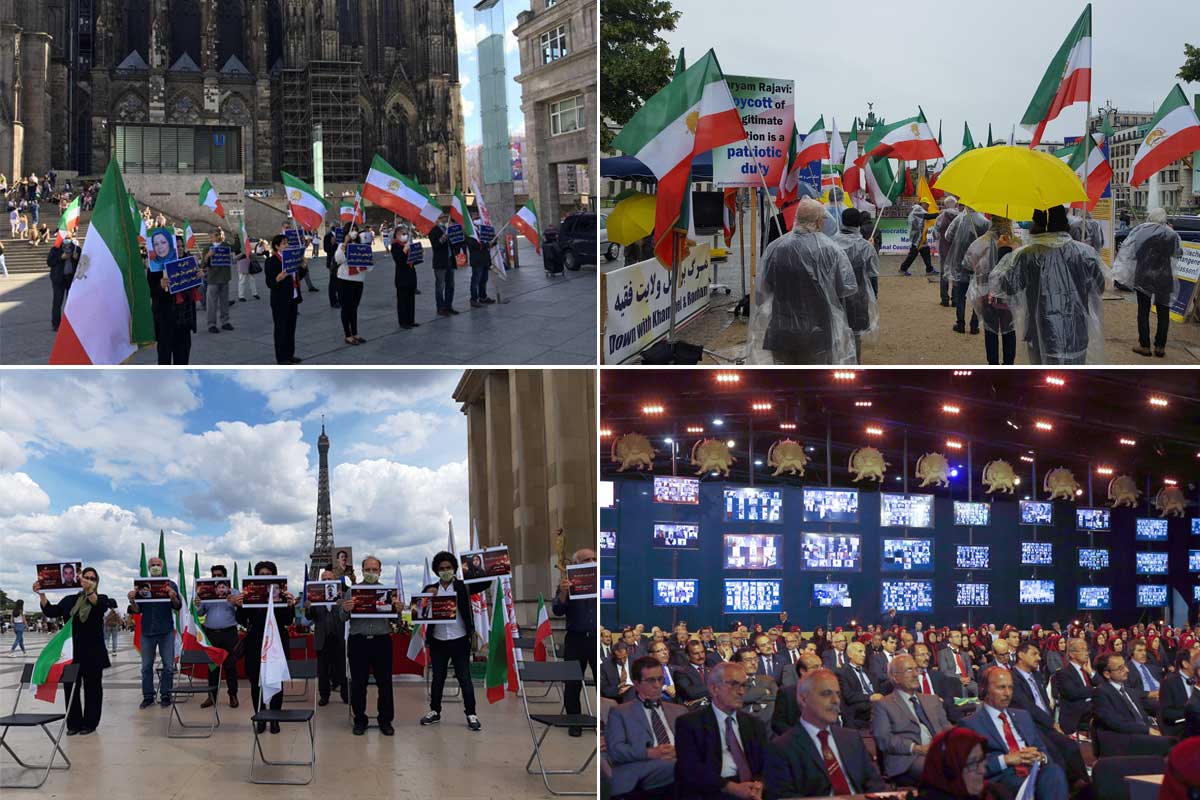
Demonization Campaign
Due to their desperation, the ruling mullahs have resorted to the proliferation of failed demonization campaigns against the PMOI.
In the notorious centers of the MOIS and the terrorist Qods Force, they have drafted and signed a petition, with 8,000 signatures, in order to call for the travel of PMOI families to Albania.
Defectors-turned-MOIS-agents abroad have been tasked with spreading nonsense against the Iranian Resistance.
Confronted with an all-embracing social tribute to the late Marjan and her commitment to the struggle, they published a fabricated issue of the PMOI’s newspaper Mojahed in order to intimidate artists into taking a stance against the PMOI, which is the most frightening red line for the regime.
They attacked (post-revolutionary prime minister) Mehdi Bazargan for supporting Massoud Rajavi’s candidacy during the first round of parliamentary elections, and published a fake tweet from me regarding Bazargan, in order to obstruct plans to name a street (in Tehran) after him.
Let me summarize: There is not a single day in which the regime ceases to spread lies and demonization against the PMOI and the Iranian Resistance.
But, this attempt has backfired and inadvertently, every day, the regime is actually pointing the Iranian society and especially the youth who are seeking freedom and justice to the direction of its democratic alternative.
The regime is noticing clearly that the proud and blossoming generation of young people has found the answer for the future and for freedom in a full-fledged struggle against the regime, a struggle that has the same character as the one waged on June 20, 1981.
On May 17, 2020, Khamenei said: “They (the PMOI) are working on attracting the youth and are making plans in this regard.”
On the other hand, Khamenei’s Headquarters is making plans as well. They have launched an extensive wave of arbitrary arrests, detaining university students and youths, and are conspiring against the Iranian Resistance.
Four days ago, I mentioned that the clerical regime has marshaled its political and intelligence apparatus to close the legal case regarding (the assassination of) Prof. Kazem Rajavi, the great martyr for human rights, even though this example serves as one of the strongest cases in terms of its legal evidence involving the regime’s state-sponsored terrorism.
But, the Iranian Resistance will shatter the chain of plots by the clerical regime in its final phase.
At this juncture, the primary issue for the crisis-ridden regime is to eliminate the sole democratic alternative in order to ensure the mullahs’ survival.
During this period, we are witnessing multi-faceted attacks and counter attacks amid the regime’s factional feuds. Those unfamiliar with the state of affairs in the regime, or with the crises it is facing, or with its fear of the Iranian Resistance, may be surprised as to why the regime has given free rein to its agents to attack even Khamenei himself in order to balance the slanders and systematic hostility towards the PMOI. So long as they respect the regime’s only red line, the PMOI and the Iranian Resistance, the apparent attacks on the regime’s supreme leader is a diversionary tactic designed to make it harder to identify the Intelligence Ministry’s agents.
As the NCRI said in its statement seven years ago, the familiar ‘code-word’ of the mullahs’ Intelligence Ministry is the claim that apparently the PMOI and their NCRI colleagues immediately accuse anyone opposing them to be intelligence agents. The purpose of saying this is to create a political shield to protect collaborators, agents and contacts of the mullahs’ intelligence service and consequently whitewash their image so that they can pose as ‘critics’ or ‘opponents of the PMOI.’ As far as it concerns the mullahs’ intelligence service, coining the term ‘former PMOI members’ pursues the same goal. In the past years, security agencies and protection offices in various European countries have, in their reports, repeatedly exposed these types of attempts by the mullahs’ intelligence service, which are meant to infiltrate the ranks of the opposition.
As an example, Germany’s Federal Office for the Protection of the Constitution (BfV) announced: “The Iranian (regime’s) espionage activities against Germany are primarily conducted by the MOIS. The PMOI and the NCRI, in particular, are the core targets of such activities.”
The Dutch General Intelligence and Security Service (AIVD) also declared: “AIVD has discovered that Iran’s MOIS is leading a network of people in Europe. Members of this network are comprised of former PMOI members who have been recruited by the Iranian MOIS. They are tasked with portraying the PMOI in a negative light in the eyes of public opinion, and with gathering intelligence about the PMOI for the MOIS.”
In Albania, too, after terrorist plots, after the expulsion of the regime’s ambassador and intelligence agents in that country, after the press conference held by the Albanian police chief regarding the regime’s espionage and terrorist activities against the PMOI under the guise of family members and journalists, and after Khamenei’s threats against Albania, two days ago, Albanian Prime Minister Edi Rama once again warned about the regime’s belligerent activities on Albanian soil and added that such menacing actions by the regime has forced Albania to take steps against them.
The Albanian Prime Minister said unequivocally: “Based on facts and examples, we know how this regime operates in Albania, regardless of their ideology or whatever they call themselves.”
He emphasized: “We are very proud to have been able to help the PMOI.”
So, it is clear that claims about this regime, its Qods Force, MOIS and its agents are based on facts and examples. Therefore, the MOIS ploys seek to distract from this reality and they have been exposed a long time ago.
That is why, two days ago, the PMOI and the NCRI’s Judicial Committee once again invited accusers to bring their claims to courts so that everything can be exposed.
Opposing the Export of Terrorism
Exposing and also confronting the Iranian regime’s policy of exporting terrorism and fundamentalism in the past four decades, an effort in which the NCRI and the PMOI have been fully engaged, are part and parcel of the broader campaign to overthrow the ruling religious fascism. Allow me to inform the Iranian people that the ruling theocracy’s extensive two-year conspiracies and efforts to save its arrested diplomat in Belgium have so far proven futile, owing to a series of legal initiatives and a plethora of evidence, documents and testimonies. After a two-year investigation, the first closed-door court hearing will soon be convened.
Two years ago, on June 30, 2018, the clerical regime planned a major massacre, perhaps its largest terrorist massacre, targeting the Resistance’s gathering in Villepinte, near Paris, which was thwarted at the last minute and the terrorists were apprehended.
Obviously, in the past two years, the Iranian regime has spared no effort and pressure to secure the release of the terrorists and the closure of the case. But it failed to prevent the continuation of the investigation and the start of the trial. So far, this is a victory for all those combating terrorism. I emphasize that this is only the beginning and the regime’s leaders must face legal justice as the greatest perpetrators of terrorism in the world today, as should their agents and mercenaries inside and outside Iran as accomplices in the commission of crimes.
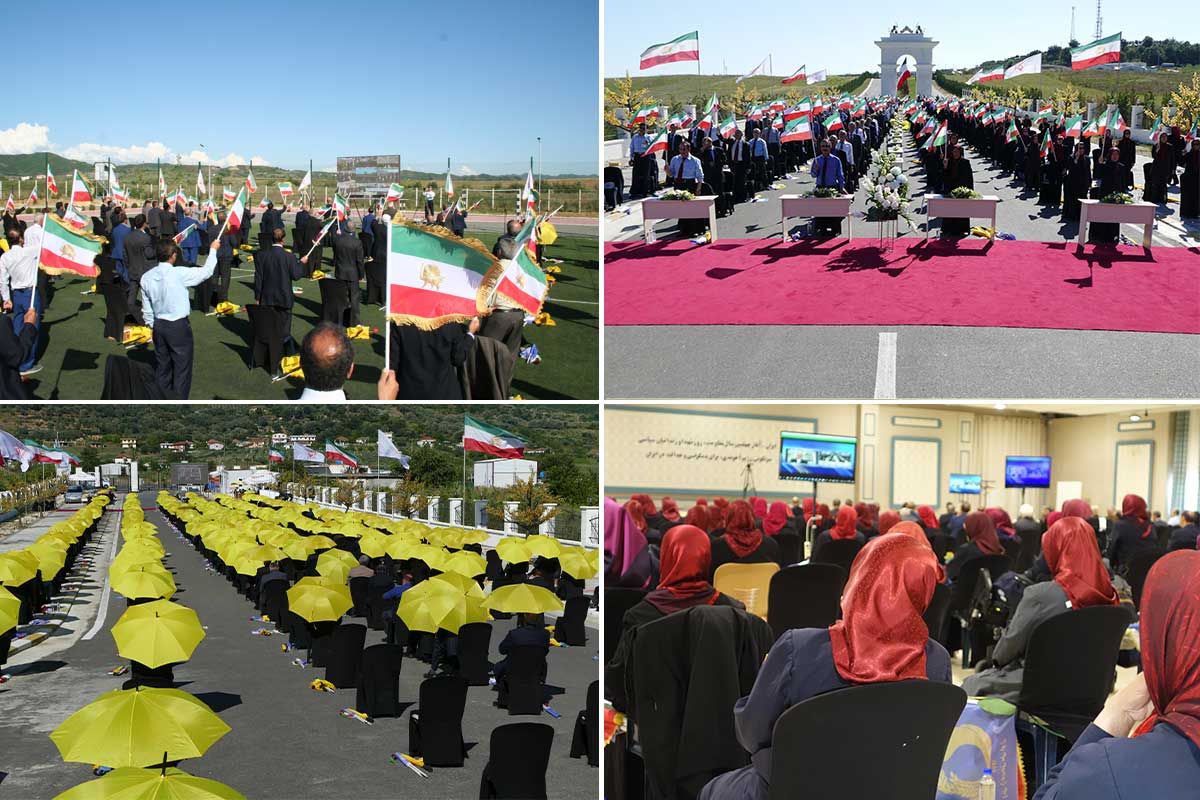
The overthrow of the clerical regime remains to be the unyielding demand of the Iranian people, and the uprisings in November 2019 and January 2020 represented the people’s burning commitment to implement it.
With their protests and strikes, and the activities and operations of Resistance Units, every day, the Iranian people move closer to overthrowing the regime.
It is for the realization of this goal that political prisoners continue to persevere in prisons across Iran and stand up to Khamenei’s henchmen.
It is up to the international community to hear this message:
We have always said and reiterate that this regime should not be allowed to obtain even a single bullet; it should not pocket even a single dollar in oil revenues; and it should not spend even a single dollar out of revenues that belong to the Iranian people.
The Iranian Resistance has also emphasized since a long time ago that it seeks the restoration of the six UN Security Council resolutions against the regime.
We emphasize the extension of international sanctions against any form of weapons trade with the regime.
The global community must recognize the right of rebellious youth, Resistance Units and the Iranian people to resist against the religious tyranny.
The leaders of this regime must face justice in international courts for the killing of 120,000 children of the Iranian people, including the 1988 massacre of 30,000 political prisoners, and the killing of over 1,500 Iranian protesters in November 2019.
The Resolution of the US House of Representatives
The resolution signed by the majority of members in the U.S. House of Representatives, which has recognized the Iranian people’s right to the establishment of a democratic republic based on the separation of religion and state provides a credible model for all governments and the international community to follow regarding Iran and the Iranian people.
The resolution censures the clerical regime’s state-sponsored terrorism, and specifically, the terrorist plot against the Iranian Resistance’s 2018 annual gathering.
The spirit of this resolution can be summed up in supporting the right of the Iranian people to change the regime and to achieve a democratic republic. It states that the Iranian people have rejected the monarchical dictatorship and, as well, do not accept religious tyranny and oppose it. It also references and points to the Iranian Resistance’s Ten-Point Plan, which reflects the image of a free Iran:
1. No to velayat-e faqih; Yes to people’s sovereignty in a pluralist republic based on universal suffrage;
2. Freedom of speech, freedom of political parties and assemblies, freedom of the press and the internet; dissolution and disbanding of the IRGC, the terrorist Qods Force, plainclothes agents, the unpopular Bassij, the MOIS, Council of the Cultural Revolution, and all of the suppressive patrols and institutions in cities, villages, schools, universities, offices, and factories;
3. Commitment to individual and social freedoms and rights in accordance with the Universal Declaration of Humans Rights; dissolution of all agencies in charge of censorship and inquisition; seeking justice for the massacred political prisoners, prohibition of torture, and abolishment of the death penalty;
4. Separation of religion and state, and freedom of religions and faiths;
5. Complete gender equality in political, social, cultural, and economic rights, and equal participation of women in political leadership; abolishment of any form of discrimination; the right to choose one’s clothing, and to marriage, divorce, education and employment; prohibition of all forms of exploitation against women under any pretext;
6. Independent judiciary and legal system in accordance with international standards based on presumption of innocence, the right to defense, the right to appeal, and the right to be tried in a public court; full independence of judges; abolishment of the mullahs’ Sharia law and dissolution of revolutionary courts;
7. Autonomy and removal of double injustices against Iranian nationalities and ethnicities in alignment with the NCRI’s plan for the autonomy of Iranian Kurdistan;
8. Justice and equal opportunities in the realms of employment and entrepreneurship for all of the people in Iran in a free market economy; restoration of the rights of blue-color workers, farmers, nurses, white-color workers, teachers and retirees;
9. Protection and restoration of the environment that has been massacred under the rule of the mullahs;
10. A non-nuclear Iran that is devoid of weapons of mass destruction; peace, co-existence and international and regional cooperation.
As we mark the 40th year of the struggle against religious tyranny, the Iranian Resistance renews its commitment to the Iranian people and to the 120,000 martyrs for freedom.
Since the outset, we have declared that our goal is not to take power at all cost. Instead, our goal is to realize the Iranian people’s desires for the establishment of freedom, justice and democracy at all cost.
Let us rise up, strengthen our national solidarity, and expand uprisings and protests in order to bring ever closer the Day of Freedom.
Hail to Freedom
Hail to the people of Iran
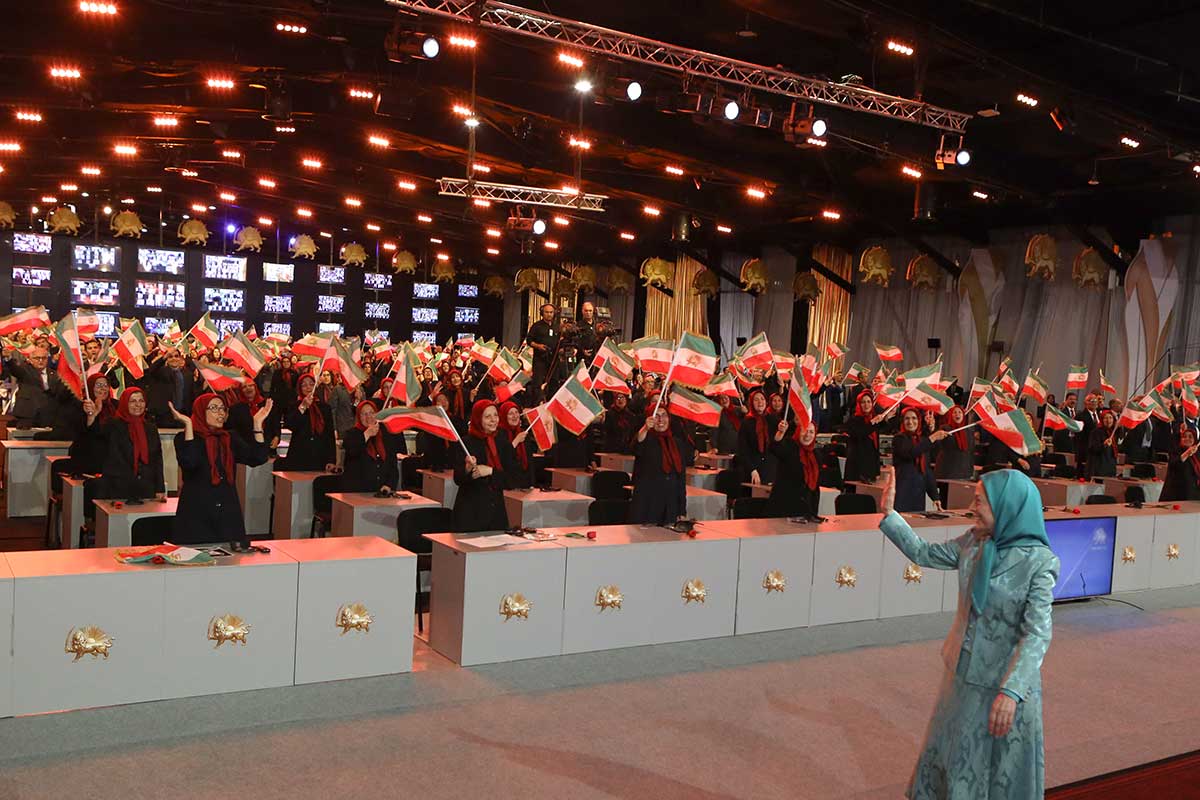
- Tags: freedom, Iran protests, Massoud Rajavi

